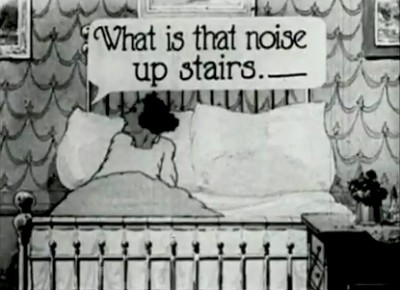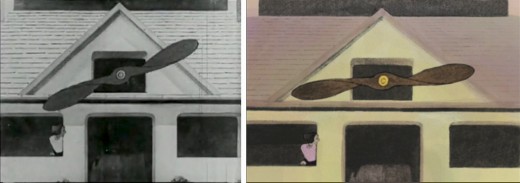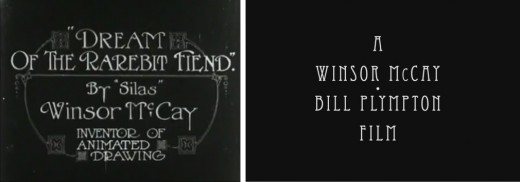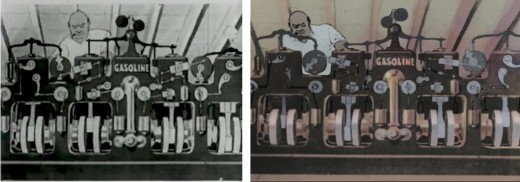Daily post 18 Oct 2011 05:47 am
The Grounded House
- Yesterday, I received the following comment from “Doug”:
- “Michael – are you aware of and if so, would you opine on Bill Plympton’s “restoration†of Winsor McCay’s Flying House?”
The short answer is, yes I am aware of this “restoration,” and on several blogs I curtly gave my opinion of this project. Unfortunately, I have not been kind about it. Bill, even called once and asked me to be in a documentary about the film and tell the camera what I thought about it. I declined, ultimately. Especially, after I saw the finished product and compared it to the original.
So, let me go into it a bit. The longer version.
The first thing that caught my eye is that it no longer is a “Winsor McCay Film;” it’s a “Winsor McCay – Bill Plympton Film.” The restorer gets equal credit with the filmmaker. Cheeky.
The balloons of McCay’s film reflect his comic strip sensibilities; this is the natural way for him to create a dialogue. Bill Plympton employed two excellent actors, Matthew Modine and Patricia Clarkson to voice the balloons which were eliminated in the “new” version of the film. They’re terrific actors, but I prefer seeing those balloons, especially since all action freezes when you’re supposed to be reading. Now with the new voices, it feels as if the screen dies whenever they speak. It doesn’t work visually, anymore.
.

The ugly balloons
We went through a long period where colorizing films was often well discussed. The comments were overwhelmingly negative just prior to CITIZEN KANE getting a new set of garish colors ingrained over the beautiful black and white cinematography of Greg Toland. Fortunately, that hasn’t happened – as yet.
Animation enthusiasts have long cried out over the colorization of the black and white WB and Popeye cartoons. To this day, Cartoon Network is showing the colorized Fleischer Popeye cartoons instead of the beautiful B&W ones. These were done the same way Plympton’s people did their handiwork. Frames were traced off and painted and put back into the whole. Along the way timing and shuffling of the artwork was done so that the new is not the same as the old.
In The Flying House, if you look at the scene of the engine room where the male of the house operates the giant propeller. The machinery acts in a very funny way in the McCay version of the film; in the Plympton version the timing is completely different and wholly unfunny. They made the task easier by only doing a portion of the job and cycling it. McCay’s scene is much longer, and the timing is constantly changing.
One can see this scene, in this late McCay animation, as an answer to what has become of the medium he originally designed, if not invented. The factory made animated films had turned to labor saving, cost-cutting devices to rush production. Cycles were a big part of the silent animated films. Paul Terry’s studio reworked cycles ad infinitum to hurry their work lode. McCay uses cycles but gives many different variations on the cycle, and shows animators how to do it. He turns the cycle into a gag. Unfortunately, the newer version of this film misses the gag entirely and obviously missed the insider’s reference that McCay was making. I’m sure animators of the day didn’t miss it. The “restoration” is a bust for this scene, alone. .
If you look closely at the images in the new version, you’ll see that there are some small changes going on in the artwork. Things have been tidied up a bit by the Plympton crew to the detriment of the McCay artists. Something is lost here; McCay’s hand.
.
The colors chosen by Bill Plympton aren’t bad – even respectful, but my preference is to see the colors chosen by McCay, in this case B&W with grays. I’m more interested in what McCay thought in making this film than I am in Plympton’s thinking.
.
In fact, the most egregious problem with “modernizing” McCay’s work is that you’re undoing decisions McCay made years ago. What if I thought that Plympton’s feature IDIOTS AND ANGELS was too morose. The colors are grayed out, and it’s all just too dark. So if I were to take a copy of his film and add brilliant colors, a laugh track to make sure people can recognize where the funny parts are, and some more pop songs throughout the film. Would that make the film better, or would I be desecrating the film? The answer is obvious, and it goes for McCay’s film as well. I don’t have the right to second guess Bill Plympton’s decisions on his film; he doesn’t the have the right to second guess McCay’s decisions – especially since McCay’s original film is considered one of the animation treasures.
.

was square has now become more of a rectangular shape.
The screen proportions have changed, and distortion has entered.
There are laws protecting certain preserved buildings in New York City, and there should also be laws protecting rare films. This is one that should have been protected.



on 18 Oct 2011 at 8:41 am 1.Joe Fournier said …
http://youtu.be/bOBHGWLfr-M
I forget how quickly animation came about. In this clip, Al Hirschfeld talks about being in the room when someone suggested that Windsor copyright the idea of animation. Windsor says, “Anybody crazy enough to make that many drawings is welcome to it.”
on 18 Oct 2011 at 9:33 am 2.Dennis Hermanson said …
I agree with your very judicious and ultimately historical feeling that great art should not be redone. McCay’s work was always great art, and anyone who feels the need to “improve” it, for whatever reason, is artistically misguided.
The impulse to honor, to homage, to gain inspiration from, to learn from… right on!
To re-do, clean, simplify, re-color or baste like a turkey in the oven of art… In the words of Betty Boop, “No! No! A thousand times, no!!” (And sadly, she went from a teasing stage-star to a housefrow with a too-cute puppy and a Grampy with no love interest either.)
Thanks for your report and honest appraisal.
Dennis Hermanson
Hillsborough, NC USA
on 18 Oct 2011 at 9:44 am 3.Dennis Hermanson said …
I am left with one “follow-up” question to tease you with, Michael.
What do you think of the restoration of the Sistine Chapel?
I have my opinion, having two wonderful books, the before book, and the after book (or the pre-book, depending on how you look at it…)
What’s your take?
And do you sense the Sistine Chapel as an animation “in situ?”
Dennis Hermanson
Hillsborough, NC
on 18 Oct 2011 at 10:13 am 4.Doug said …
Michael, I am thrilled to be answered with such a post here! Thanks for your opinions and very in-depth analysis of this project. I concur with you 100% and in fact, wrote Mr. Plympton to tell him so. I didn’t hear back from him, though I didn’t expect to.
There is a potentiol upside to this project. I read on the blog for the Flying House Project that if the funds are available after doing the colorized restoration, they may take on doing a proper restoration without the voice track. There is hope.
Thanks again for a marvelous blog (one of my daily stops)!
-Doug
on 18 Oct 2011 at 1:04 pm 5.Amid said …
I think the problem with Bill’s project is that he showed too much reverence for the original and tried to literally recreate it. I would have rather preferred if he’d done what a musician does -— sampled imagery and animation from McCay and incorporated into one of his own films. (Think about it this way: if a musician likes an older piece of music, he’ll either sample it into an original composition, or he’ll re-record it. But he wouldn’t clean up an original recording and then add new sounds into that recording.)
Bill also misunderstood that the reason a fifteen-year-old might find McCay’s film boring today isn’t because it lacks color or sound. It’s because the pacing and storytelling are a hundred years out-of-date with contemporary sensibilities. His version doesn’t address that, and thus, would still put a younger person to sleep. Resampling McCay’s ideas into a contemporary production, as a musician would sample an old song, would have stripped away the outdated parts of McCay’s filmmaking style while highlighting the continuing freshness of his concepts and ideas.
on 18 Oct 2011 at 2:49 pm 6.The Gee said …
That annoying trend in movies where a director gets top billing over a classic writer’s name may have been a good way to go here. So, it would be like:
“Bill Plympton’s Windsor McKay’s The Flying Houseâ€
Lame, yeah. But, otherwise maybe it should have been credited in a very different fashion. Since I haven’t seen anything more than what’s been shown above (and maybe a teaser?) I won’t guess.
What he did obviously won’t replace the originals. (are those included in the collection?)
It is kind of rare that a remake gains prominence over the original work, especially if they are faithful adaptations, or restorations. Wasn’t there a remake of “Metropolis� I doubt it gets kudos over the original version.
I agree with Amid that like a musician doing a cover it would have been cool to see a colorized zippy version that was based on McKay’s shorts. Something new. But, it would be more of Plympton’s own shorts than restorations of some sort.
I don’t feel so bad about this because it doesn’t destroy the original. But, from a creative and a business standpoint I am not really enthusiastic about it. As if I matter though….
on 18 Oct 2011 at 7:50 pm 7.Chris Sobieniak said …
“Note that the screen proportions have changed. What once was square has now become more of a rectangular shape. The screen proportions have changed, and distortion has entered.”
All for the sake of our 16:9 mentality I take it.
As the ol’ saying goes, if it ain’t broke, why fix it?
on 19 Oct 2011 at 11:08 am 8.Doug said …
I am surprised that this has not shown up on Cartoon Brew yet. Amid?
I think the main problem with this “restoration” for me is that many for many viewers, perhaps most, this will be the only version of McCay’s film that they will see. And we all know, that in the end it will not be McCay’s film but a hybrid of McCay’s film with Plympton’s vision of it. Therefore, in a sense it is revising film history, which Michael spoke to in his comments. This is more than cheeky to me, it is alarming.
on 19 Oct 2011 at 3:59 pm 9.Bill Plympton said …
Dear Michael,
I want to thank you for your heartfelt comments on the updating of Winsor McCay’s last film, “The Flying Houseâ€. I’ve been getting a lot of negative criticism about the project, so I’d like to set the record straight about my involvement in the production.
First, I’m a huge fan of the genius Winsor McCay. In fact, I feel a real kinship to him – he came from the country to New York City to make his fortune, like I did. He started in print and moved to animation later in his career, like I did. He used surrealism as a source of humor, like I did. He remained an independent animator all his life, and he did every drawing himself, like I do.
I was watching the collection of Winsor McCay films a few years ago, and after watching “The Flying Houseâ€, the thought occurred to me that it’s tragic that more people don’t know of this film and his work in general, mostly because it’s so old, black and white, silent, and very long due to the intertitles. I just did a show at Lincoln Center and asked how many people knew who Winsor McCay was – one person raised his hand. At the San Diego Comic Con, I asked a large audience how many people had seen “The Flying House†– not one person raised their hand.
Wouldn’t it be cool if I asked that question and everyone raised their hands?
Despite John Canemaker’s magnificent book, Mr. McCay is disappearing into obscurity.
So, I decided to update “The Flying Houseâ€, one of his most obscure films. I received a digital master from Lobster Films in France. I hired a staff, paid for out of my pocket, to meticulously clean the scratches and deterioration from every frame. That process took about 2 years. Then my staff colored the film, closely following the colors used in his Sunday print cartoons. I hired Matthew Modine and Patricia Clarkson to read the dialogue so we could lose the intertitles that really distracted from the appreciation of great art. The voices also added a deep feeling of personality to the characters.
I added music, as is common for a lot of old silents like Buster Keaton and Charlie Chaplin (check out TCM.) And even though I raised money through Kickstarter and The Society of Illustrators, I’m going to lose money on the film. Sadly, I can’t imagine any TV channel or theatrical release for this film.
I do plan on releasing the new version on DVD along with the original, including interviews with animation scholars. Although it’s hard to get well-known scholars to give their complaints about the project on camera. Both you and John Canemaker declined to be interviewed on camera. I’d love to get negative thoughts about the remake in the DVD – I believe it’s an important issue.
My goal in this project is not to get rich, but to spread the gospel of Winsor McCay to a new audience.
People have been re-using great art since art began. There have been thousands, perhaps millions of remakes of the Mona Lisa on T-shirts, towels, billboards, cartoons, illustrations, posters – have they damaged the art of the original? No, they’ve made Leonardo da Vinci and his painting much more famous. That’s what I want to do with Winsor McCay!
God save me from the purists.
on 20 Oct 2011 at 8:41 am 10.Heidi said …
“My goal in this project is not to get rich, but to spread the gospel of Winsor McCay to a new audience.
People have been re-using great art since art began. There have been thousands, perhaps millions of remakes of the Mona Lisa on T-shirts, towels, billboards, cartoons, illustrations, posters – have they damaged the art of the original? No, they’ve made Leonardo da Vinci and his painting much more famous. That’s what I want to do with Winsor McCay!”
Sounds like Plympton wants to brand Winsor McCay. Why not spread the gospel of Mr. McCay as Mr. McCay and not a hybrid of Plympton and McCay. I, too, came from the country to NYC to make my fortune, I too…
on 21 Oct 2011 at 11:02 am 11.George Griffin said …
I haven’t seen Bill’s film but based on these comments and pictures:
1. It goes too far beyond restoration. Buildings, even landmarks, do profit from this because they are not just art; they have to house people and conform to their needs. Not so for art. “Improving” a masterpiece, like “Gertie,” would be a big problem, but why is it acceptable for minor historical work like “The House?”
2. Titles and speech balloons, even if they “stop the action,” are intrinsic to montage. They provide a film’s rhythm. They are not deficits that need to be discarded by adding famous actors’ voices (a strategy that diminishes the visual art in favor of marketability).
3. Missing in this debate is the creative commons idea. Does Bill’s restoration rise to level of bad art? Does it merely copy an earlier work (like Van Sant’s shot-by-shot version of “Psycho”?), or does it re-interprete (like Nina Paley), or is it like Jeff Koons’ witty appropriations of kitsch? Hmmm.
4. Did McCay’s comic strips indicate his ideas about color or did they just come from the newspaper printing process. If the former, then Bill’s “tasteful” palette would seem to be a curious, inauthentic intrusion, especially considering Bill’s own vivid ‘Hamburger” film.
5. Bill’s comments above are too self-serving. Does he really believe Mona Lisa t-shirts boost Leonardo’s status. Hasn’t he read that Walt crowed about “Fantasia” something like, “This will really make Bach.” How does losing money on a project justify one’s artistic practice? Maybe he’s just pulling our leg. I can well understand John’s and Michael’s reluctance to critique the film on camera. This would simply be an “extra” commentary to pad out the DVD.
Finally, Bill seems to have fulfilled his mission to bring McCay to the masses—a laudable, democratic enterprise. He’s a truly great, original animator and is certainly entitled to a stumble now and then.
GG